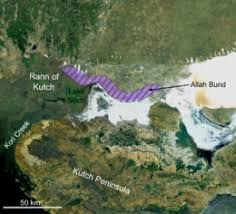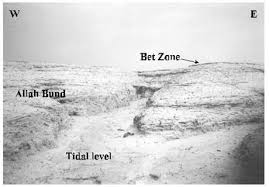The 1819 Rann of Kutch seismic tremor happened at about 18:45 to 18:50 nearby time on 16 June.
It had an expected size going from 7.7 to 8.2 on the second extent scale and a greatest saw power of XI (Extreme) on the Mercalli force scale.
It set off a tidal wave and caused in any event 1,543 passings.
The seismic tremor caused a territory of subsidence that shaped the Sindri Lake and a nearby zone of elevate toward the north around 80 km long, 6 km wide and 6 m high that dammed the Koree/Kori/Puran/Nara waterway. This regular dam was known as the Allah Bund ("Dam of God").
Structural setting:
 The Kutch District of cutting edge Gujarat lies 3–400 km from the plate limit between the Indian Plate and the Eurasian Plate, however the current tectonics is still administered by the impacts of the proceeding with mainland crash along this limit. Throughout the separation of Gondwana in the Jurassic time frame, this territory was influenced by breaking with a generally west–east pattern. During the impact with Eurasia the region has experienced shortening, including both reactivation of the first break deficiencies and improvement of amazing failure edge push flaws. The related collapsing has shaped a progression of reaches, especially in focal Kutch. The central system of most tremors is predictable with turn around blaming on reactivated fracture shortcomings. The 2001 Gujarat seismic tremor was brought about by development on a formerly obscure south-plunging deficiency, slanting corresponding to the deduced crack structures.
The Kutch District of cutting edge Gujarat lies 3–400 km from the plate limit between the Indian Plate and the Eurasian Plate, however the current tectonics is still administered by the impacts of the proceeding with mainland crash along this limit. Throughout the separation of Gondwana in the Jurassic time frame, this territory was influenced by breaking with a generally west–east pattern. During the impact with Eurasia the region has experienced shortening, including both reactivation of the first break deficiencies and improvement of amazing failure edge push flaws. The related collapsing has shaped a progression of reaches, especially in focal Kutch. The central system of most tremors is predictable with turn around blaming on reactivated fracture shortcomings. The 2001 Gujarat seismic tremor was brought about by development on a formerly obscure south-plunging deficiency, slanting corresponding to the deduced crack structures.Quake
The quake went on for a few minutes. It was felt over a tremendous region, from Chennai to Kolkata in the east, as far north as Kathmandu and as far west as Balochistan. The mainshock was trailed by delayed post-quake tremor movement, with serious seismic tremors proceeding for at any rate 50 years, incorporating one with evaluated extent of more than 6.5 in 1846.
Greatest dislodging during the seismic tremor is assessed at 12 m, in light of the tallness of the bund and the measure of subsidence toward the south. Joined with a sidelong degree of in any event 80 km, this gives an expected greatness of 7.7±2. This matches well with sizes evaluated utilizing both the all out felt zone and the region of VIII intensity.[3] Other appraisals dependent on force estimations give extents as high as 8.2.
Demonstrating of the surface twisting shows that the issue that slipped during the seismic tremor plunged toward the north at between around 50–67°. As flaws that dunk in overabundance of 50° are regularly ominous for slip, it has been proposed that there was moderately high pore-liquid compel created at profundity to permit this uprooting to occur.There is proof that the Indus stream moved westwards after this earthquake.
Allah Bund:
 The most evident geological impact of this quake was the development of an edge around 6 m high, stretching out for 80 km (potentially as much as 150 km) that framed a characteristic dam over the Puran river.To recognize it from the man-made dams that were normal in the district, the inspired zone got known as the Allah Bund, or Dam of God.The hill created had a uniquely uneven geometry, with a shorter and more extreme south-plunging edge, around 600 m wide and a plunge of 0.65°, and a more extensive north-plunging edge more than 5 km wide with a plunge of just about 0.05°.
The most evident geological impact of this quake was the development of an edge around 6 m high, stretching out for 80 km (potentially as much as 150 km) that framed a characteristic dam over the Puran river.To recognize it from the man-made dams that were normal in the district, the inspired zone got known as the Allah Bund, or Dam of God.The hill created had a uniquely uneven geometry, with a shorter and more extreme south-plunging edge, around 600 m wide and a plunge of 0.65°, and a more extensive north-plunging edge more than 5 km wide with a plunge of just about 0.05°.Sindri Lake
Sindri Lake, with a surface region of more than 1,000 km2, was shaped because of subsidence of up to 3 m south of the Allah Bund. At first, the lake was cut off from the waterway (damming further upstream had halted the stream) and was loaded up with seawater. On the western edge of the lake a little delta worked out from the eastern piece of the bigger Indus Delta. After 1826 the stream got through the counterfeit dam and in the long run got through the bund itself, making the lake become freshwater once more
Visit Official Home Page




0 Comments